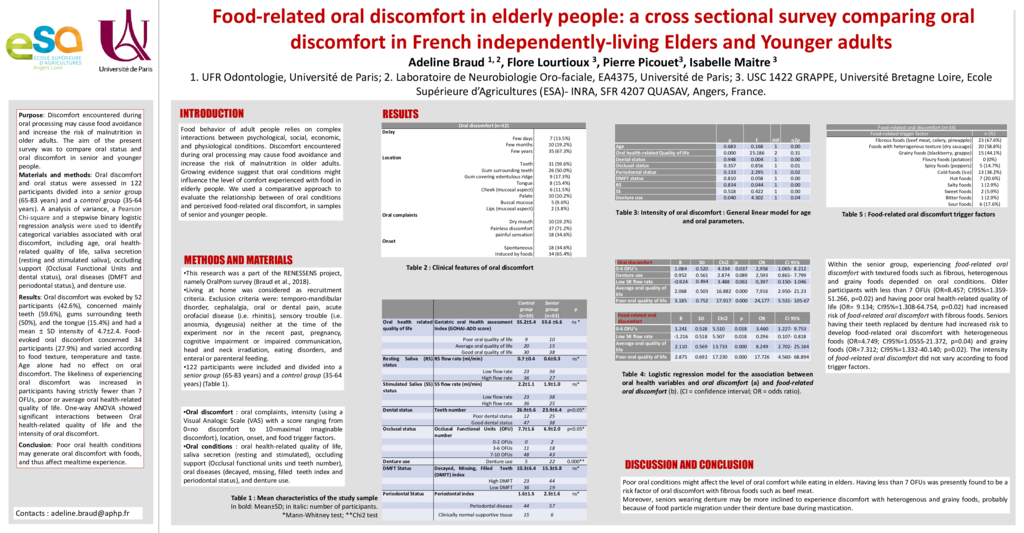Discomfort encountered during oral processing may cause food avoidance and increase the risk of malnutrition in older adults. The aim of the present survey was to compare oral status and oral discomfort in senior and younger people.
Oral discomfort and oral status were assessed in 122 participants divided into a senior group (65-83 years) and a control group (35-64 years). A analysis of variance, a Pearson Chi-square and a stepwise binary logistic regression analysis were used to identify categorical variables associated with oral discomfort, including age, oral health-related quality of life, saliva secretion (resting and stimulated saliva), occluding support (Occlusal Functional Units and dental status), oral diseases (DMFT and periodontal status), and denture use.
Oral discomfort was evoked by 52 participants (42.6%), concerned mainly teeth (59.6%), gums surounding teeth (50%), and the tongue (15.4%) and had a mean±SD intensity of 4.7±2.4. Food-evoked oral discomfort concerned 34 participants (27.9%) and varied according to food texture, temperature and taste. Age alone had no effect on oral discomfort (Chi2=0.461; p=0.497). The likeliness of experiencing oral discomfort was increased in participants having strictly fewer than 7 OFUs (OR=2.958; CI95%=1.065-8.212; p<0.05), poor (OR=24.177; CI95%=5.531-105-67; p<0.05) or average oral health-related quality of life (OR=7.916; CI95%=2.950-21.23; p<0.05). One-way ANOVA showed significant intercations between Oral health-related quality of life (F(2,121)=26.588; p<0.05; η2p=0.31) was a significant factor of the intensity of oral discomfort. Within the senior group, experiencing food-related oral discomfort with textured foods such as fibrous, heterogenous and grainy foods depended on oral conditions. Older participants with less than 7 OFUs (OR=8.457; CI95%=1.359-51.266, p<0.05) and having poor oral health-related quality of life (OR= 9.134; CI95%=1.308-64.754, p<0.05) had increased risk of food-related oral discomfort with fibrous foods. Seniors having their teeth replaced by denture had increased risk to develop food-related oral discomfort with heterogeneous foods (OR=4.749; CI95%=1.0555-21.372, p<0.05) and grainy foods (OR=7.312; CI95%=1.332-40.140; p<0.05). The intensity of food-related oral discomfort did not vary according to food trigger factors.
Poor oral conditions might affect the level of oral comfort while eating in elders. Having less than 7 OFUs was presently found to be a risk factor of oral discomfort with fibrous foods such as beef meat. Moreover, seniors wearing denture may be more inclined to experience discomfort with heterogenous and grainy foods, probably because of food particle migration under their denture base during mastication.
- 29 views



